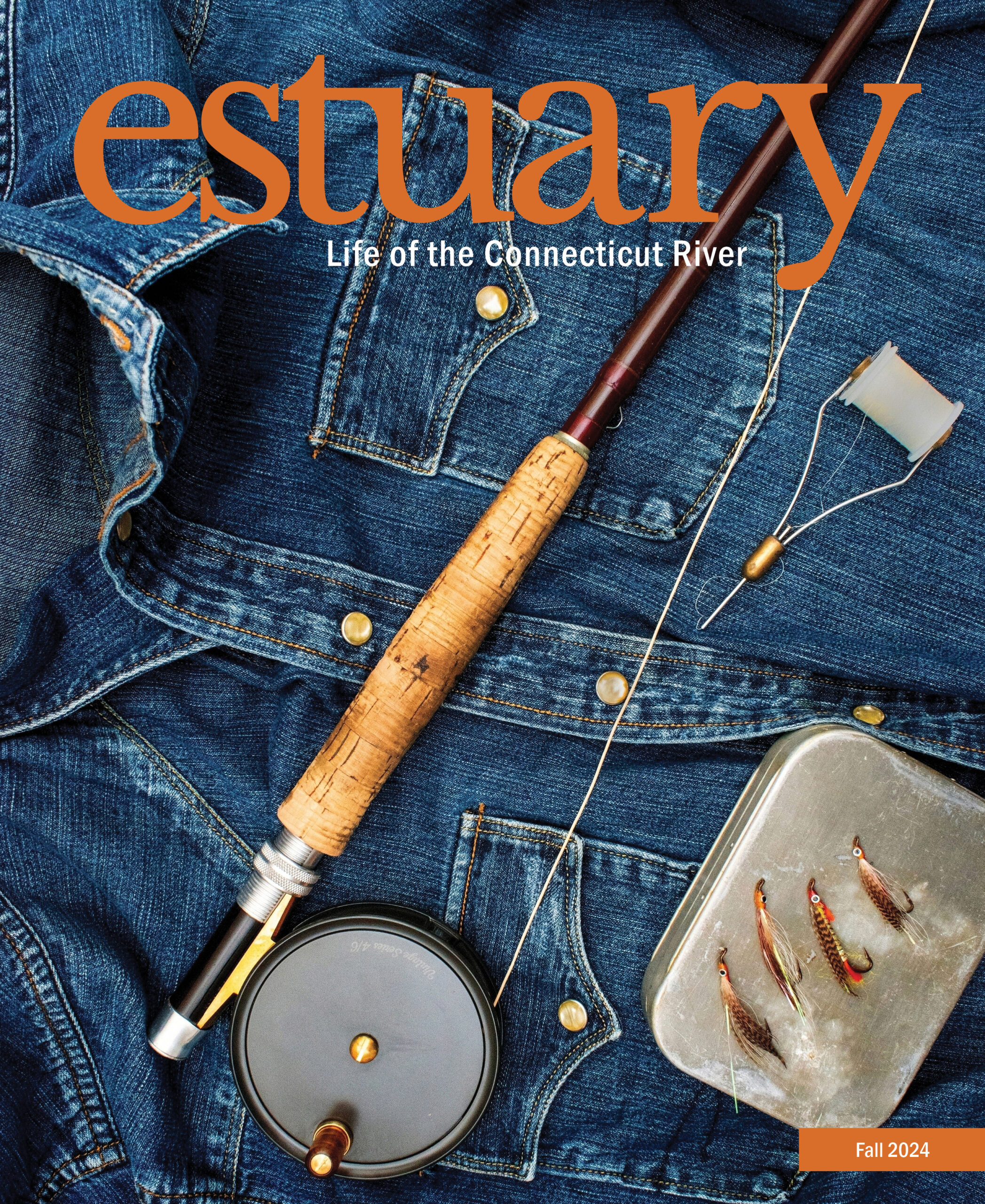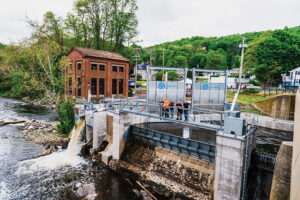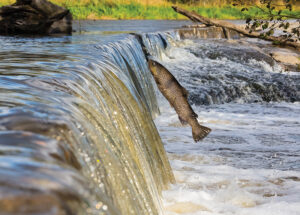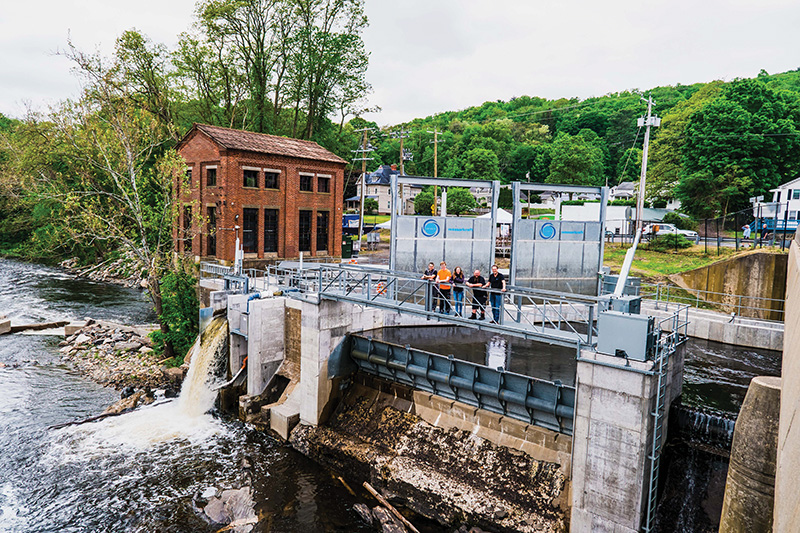 This article appears in the Fall 2024 issue.
This article appears in the Fall 2024 issue.

Mark your calendars: Spring 2026. That is when we celebrate the next biennial World Fish Migration Day (WFMD).
This year, the date was May 25. The event was memorialized across the watershed by a number of our River Partners, but Estuary joined the Connecticut River Salmon Association and our “Below the Surface” columnist Steve Gephard at the Upper Collinsville Hydroelectric Power Plant on the Farmington River in the Collinsville section of Canton. The dam at this site powered the formidable Collins Axe Company until it closed in 1966. In its heyday, this company produced 1,300 different “edge” tools for sale internationally, items such as machetes, picks, swords, bayonets, and adzes. The company built two dams to provide electric power for its operations. Today, the Upper Collinsville Dam, pictured here, has a modest, newly renovated powerplant and modern fishway.
Steering the event was Gephard himself, a veteran of forty-two years with CT DEEP in charge of migratory fish restoration; Steve aided in the design of the fishway at this site. Here one can see, firsthand, the tradeoffs between the beneficial economic and environmental aspects of hydropower versus what’s right for fish migration. About 100 visitors filed through the complex during the event.

The Collinsville Dam and fish ladder complex. Image Credit: WSS Wasserkraft, via Markus Peherstorfer.
The power plant and the fishway were recently commissioned into service. In 2015 the Town of Canton issued a request for proposals to modernize and put back into operation the Collinsville Hydroelectric Power Plant. A group of environmentally conscious engineers and architects operating under the name Canton Hydro won the bid as developing partner. Thereafter, an Austrian firm, WSS Wasserkraft, was retained as a turnkey solution provider; WSS Wasserkraft operates the plant today, unmanned, except via computer monitors in an office in Neufelden, Austria. The plant resumed operations in 2020 after a hiatus of fifty-four years.
The plant produces one megawatt of electricity, enough to provide the electricity for 500 homes. Of course, the cleaner energy offsets a great deal of carbon dioxide, as well.
The redevelopment project included the design and construction of a Denil-type fishway that enables fish to swim upstream to spawn. The fish are protected from the turbines by screens and other measures. River flows are modified to help fish find the route to go up and over the dam safely. With the reopening of this complex in 2020, not only does it generate clean, affordable power, but fish are able to spawn upstream for the first time in 150 years. (Steve Gephard and Sally Harold have reported extensively in Estuary on work to improve fishways and fish migration—search “fishways” on our website to find this important reporting.)
Free-flowing streams and rivers are of course the best means of fish migration, so removing unnecessary and unused dams is a major environmental effort throughout the country today. The National Oceanic & Atmospheric Administration (NOAA) of the US Department of Commerce is recommending $249 million in fish passage funding for forty-six projects this year, many of which will be overseen by tribal organizations. Much of this money goes to the Pacific Northwest and Maine, often to protect endangered runs of salmon; some NOAA money will be used, through CT DEEP, to remove the lower Collinsville Dam.
Washington-based American Rivers has as its goal the removal of 30,000 harmful dams in the US over the next thirty years. (Note: Dr. Andrew Fisk, Northeast Regional Director for American Rivers, is also a regular columnist for Estuary; his column is entitled “River Critters.”)

This one made it...but salmon cannot routinely leap over barriers of more than 8 or 10 feet. Image Credit: Petteri Hautamaa, Finland, via World Fish Migration Day Foundation, Groningen, Netherlands.
Not surprisingly, fish migration is a matter of grave concern throughout the world. The World Fish Migration Day Foundation (WFMDF), based in Groningen, Netherlands, attests to that. According to WFMDF, billions of people around the world depend upon migratory fish for “food, sport, research, and intrigue.” In fifty years, migratory fish worldwide have declined fifty percent. Herman Wanningen founded the organization some twenty years ago, and held the first WFMD in 2014. In the last WFMD prior to this past May, in 2022, the WFMDF reports there were 473 events worldwide, that 3,100 organizations were involved hosting 70,000 attendees, and more than 1,000 kilometers of rivers were opened up during the year.
Don’t forget! Spring 2026.


Dick Shriver
Publisher & Editor
P.S. This is just the opening salvo on a series of articles planned on the subject of dam removals within the Connecticut River watershed.
Dam Removals have proven to be one of the most effective ways to restore fish stocks and biodiversity in rivers.

